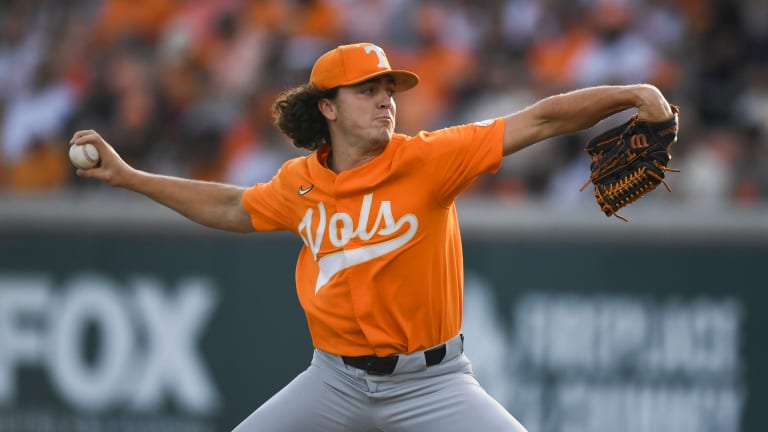
Could the Twins go off the script in the 2023 MLB Draft?

The Minnesota Twins were the big winners of MLB's inaugural draft lottery last winter, moving up from the 13th best odds to the fifth overall pick in this year's MLB Draft.
With LSU's Dylan Crewes and Paul Skenes, Florida's Wyatt Langford and high schoolers Max Clark and Walter Jenkins considered top prospects in this year's class, the Twins are in a good spot to take whichever player out of that group falls to them. But the MLB Draft is different than most sports, which could lead the Twins to go off the grid when they're on the clock.
"If one of them [goes away from the top five players], I guess Minnesota would be the best choice," MLB.com draft analyst Jim Callis said in his recent mailbag article. "...Perhaps they won't love whichever of the big five is available as much as they did the others, leading them to cut a deal to save money so they can spend lavishly on pick No. 34."
The words "save money" will probably make Twins fans' heads explode but this isn't a new strategy. Teams have a limited amount of money to sign all of their draft picks in a given class, which leads teams to strike a deal with a prospect that has a lesser signing bonus demand in order to spend above slot value later in the draft.
This is important when considering high school players, who could take the money or decide to go to college for three years to enhance their value.
The Houston Astros did this during the 2012 draft when they chose Carlos Correa over Byron Buxton. With the savings the Astros had from selecting Correa, they took Lance McCullers with the 41st overall pick and signed him to a signing bonus that was above his slot value.
The Twins also did this during the 2017 draft when they took Royce Lewis over consensus top pick Hunter Greene. Lewis signed a deal slightly below slot value and the Twins used that savings to sign Brent Rooker, who they selected with the 35th overall pick. (We won't talk about how Rooker is doing these days.)
This also happened in the 2021 draft when the Pittsburgh Pirates worked a discount deal with catcher Henry Davis, who was selected with the No. 1 overall pick over top prospects Jack Leiter, Jackson Jobe and Marcelo Mayer. The Pirates used the 37th overall pick to select Anthony Solometo, who is 1-3 with a 3.16 ERA at Pittsburgh's High-A affiliate Greensboro.
This method doesn't have the same level of success the Astros had – as they landed two key pieces to their 2017 World Series championship team – but it's one that has its reasons and could pave the way for the Twins to take a prospect outside of the "big five" in this year's draft.
This includes Chase Dollander, who was projected to be in the top tier of draft prospects after going 10-0 with a 2.39 ERA in 16 games for the Tennessee Volunteers last season. The right-hander's stock has fallen after going 6-6 with a 4.28 ERA in 14 starts this season but he's still considered to be a top-10 pick thanks to a stable of swing-and-miss pitches including a fastball in the mid-to-upper 90s.
The Twins could also go the collegiate arm route with Wake Forest's Rhett Lowder. The right-hander has catapulted into the top 10 going 13-0 with a 1.69 ERA and 114 strikeouts in 95.2 innings for the Deamon Deacons this season and also has the stuff that could help him become a top-of-the-rotation starter.
If the Twins don't select a pitcher in this scenario, they could follow Callis's recommendation of Virginia catcher Kyle Teel. The ACC Player of the Year in 2023, Teel is hitting .414/.479/.678 with 12 homers, 24 doubles and 60 RBI this season. He also brings a solid defensive presence behind the plate that would give the Twins their first elite two-way catcher since Joe Mauer was moved to first base.
But Callis warns that this scenario isn't likely for the Twins who will have their choice of a top-tier prospect in the draft. LSU's duo of Crews and Skenes would be a dream scenario for the Twins but both players are considered to be generational talents that will be off the board within the first two picks.
That could lead the Twins to Florida outfielder Wyatt Langford, who could go anywhere between the third and fifth picks in this year's draft. Langford is hitting .392/.519/.807 with 16 homers and 41 RBI for the Gators this season and while he doesn't have the speed that Crews has he is a solid defensive outfielder that in most drafts would make him a contender for the No. 1 overall pick.
If Langford isn't on the board, the Twins would have their choice of high school phenoms. Clark is a star on social media and has five-tool potential but MLB.com's scouting report believes that Jenkins has surpassed him as the nation's top high school prospect thanks to power at the plate.
In the end, the Twins are likely to just take the talent that falls and plug them into their organization which already features Lewis, Brooks Lee and Emmanuel Rodriguez. But if the Twins go off the grid, they could have their fair share of options.







